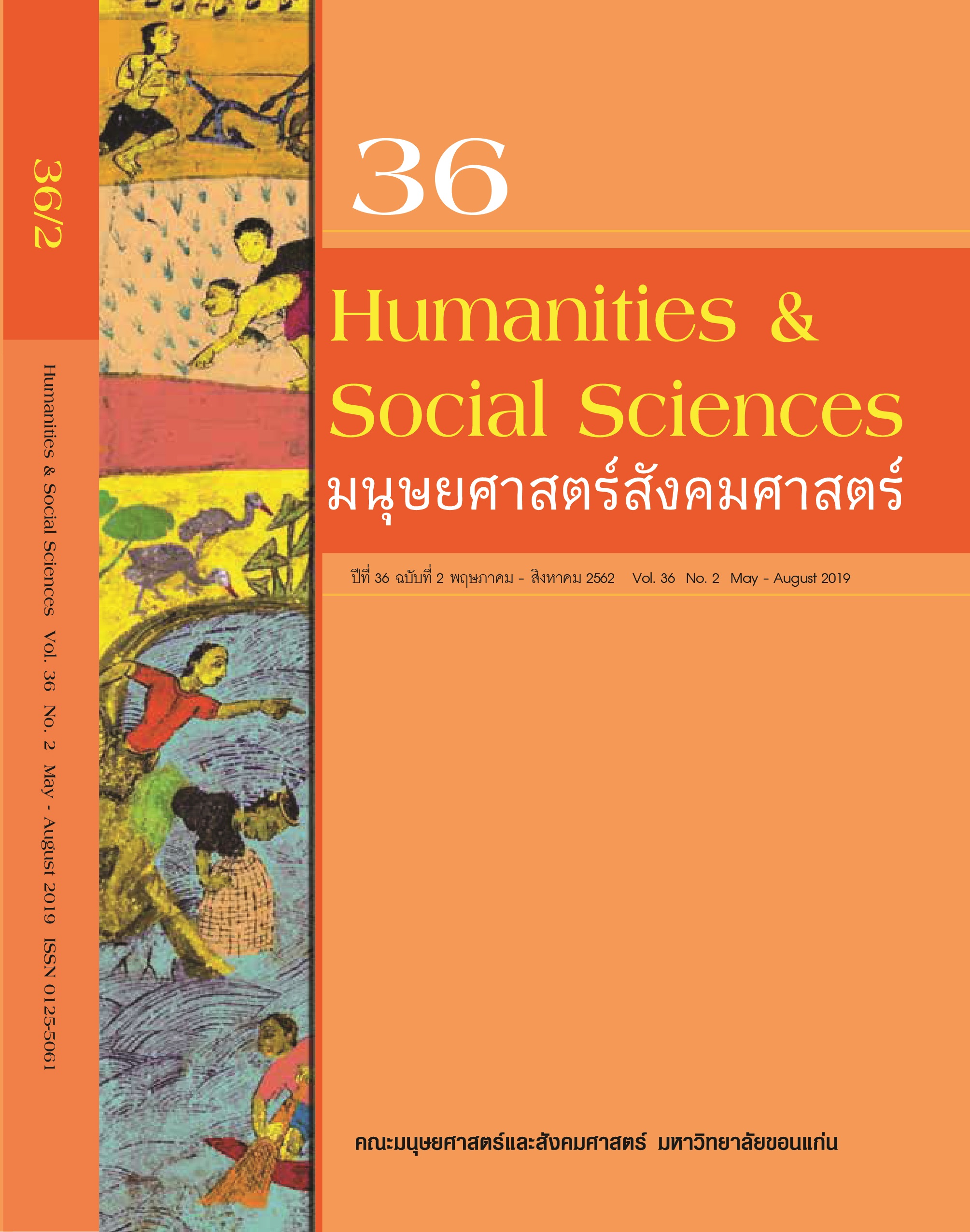ปัจจัยที่มีความสัมพันธ์ต่อสมดุลชีวิตกับงานของแรงงานในภาคอุตสาหกรรม และภาคการบริการ: กรณีงานและชีวิตส่วนตัวส่งเสริมซึ่งกันและกัน/Factors Related to Work-life Balance of Industrial and Service Labours : Dimension Work / Personal Life Enhancement
Keywords:
Work-life balance, Dimension work/personal life enhancement, Industrial and Service laboursAbstract
This research aims to study factors that related to work-life balance on dimension work / personal life enhancement of industrial and service labours. The quantitative methodology was employed with individual level as a unit of analysis. The sample consisted of 397 labours who are working in industrial and service sectors that random by systematic random sampling. The data were collected using the interview schedule from May to June 2018 and analyzed by descriptive statistics and Chi-square.
The results revealed that the most of labours samples (75.3 percentages) were female. Age of labours samples were 35.4 years old, in the generation Y (19-38 years old). The labours samples have got married (43.2 percentages). More than haft of them finished the secondary school. There are 74.1 percentages of labours samples worked in industrial and service sectors less than 10 years and more than haft worked per day more than 8 hours that over than the regulation by labour law. When analyzing factors related to work-life balance on dimension work / personal life enhancement of industrial and service labours with Chi-square, it was found that the status, education level, working hours per day are the factors that related to work-life balance on dimension work / personal life enhancement of industrial and service labours at statistically significant 0.01 level.
References
กรมส่งเสริมอุตสาหกรรม. (2560). อุตสาหกรรมไทย. ค้นเมื่อ 1 ตุลาคม 2560, จาก
https://library.dip.go.th/multim1/ebook/I%20%E0%B8%81%E0%B8%AA%E0%B8%AD 1%20%E0%B8%813%E0%B8%AA.pdf
จุฑาภรณ์ หนูบุตร. (2554). ความสมดุลระหว่างชีวิตและการทำงาน กรณีศึกษาโรงพยาบาลวิภาวดี. วิทยานิพนธ์ ปริญญาบริหารธุรกิจมหาบัณฑิต. พาณิชยศาสตร์และการบัญชี. มหาวิทยาลัยธรรมศาสตร์.
จรัมพร โห้ลำยอง. (2560). งาน ครอบครัว สังคม สมดุลชีวิตกับการทำงานที่มากกว่าการจัดสรรเวลาของ แรงงานในภาคอุตสาหกรรมการผลิต. วิศกรรมสาร มก, 19(2), 87-102.
ณรงค์กรรณ รอดทรัพย์. (2555). ปิตาธิปไตย: ภาพสะท้อนแห่งความไม่เสมอภาคระหว่างชายหญิงในสังคมเอเชีย. วารสารวิชาการ มหาวิทยาลัยราชภัฏบุบีรัมย์, 4(2), 30-46.
ดุษฎี อายุวัฒน์ และวณิชชา ณรงค์ชัย. (2556). ปัจจัยที่มีความสัมพันธ์กับความเข้าใจเรื่องสิทธิแรงงานของ แรงงานนอกระบบ ในชนบทจังหวัดขอนแก่น. วารสารมนุษยศาสตร์ สังคมศาสตร์, 30(1), 17-50.
ปิยนาถ นวลละออง. (2555). การสนับสนุนทางสังคมกับสมดุลชีวิตการทำงานของพนักงานใน โรงงาน อุตสาหกรรมจังหวัดสงขลา. วิทยานิพนธ์ปริญญาศิลปศาสตรมหาบัณฑิต. บัณฑิตวิทยาลัย มหาวิทยาลัยสงขลานครินทร์.
ปาริชาต บัวเป็ง. (2554). ปัจจัยที่มีผลต่อความผูกพันต่อองค์กรของพนักงานบริษัทไดกิ้น อินดัสทรีส์ ประเทศไทย จำกัด. วิทยานิพนธ์ปริญญาบริหารธุรกิจมหาบัณฑิต. มหาวิทยาลัยเทคโนโลยีราช มงคลธัญบุรี.
เพ็ญนภา เช้ารุ่งโรจน์. (2558). ความฉลาดทางอารมณ์และการสนับสนุนจากองค์การที่พยากรณ์ความสมดุลชีวิตกับ การทำงานของพนักงาน. วิทยานิพนธ์ปริญญาศิลปศาสตรมหาบัณฑิต. สาขาวิชาจิตวิทยาอุตสาหกรรมและ องค์การ. บัณฑิตวิทยาลัย มหาวิทยาลัยเทคโนโลยี พระจอมเกล้าพระนครเหนือ.
ภาวิณี แสนวัน. (2557). การศึกษาปัจจัยด้านส่วนบุคคล ปัจจัยด้านการทํางาน และปัจจัยด้านสังคมที่มีผลต่อความ สมดุลระหว่างชีวิตและการทํางานของพนักงานในเขตกรุงเทพมหานคร. วิทยานิพนธ์ปริญญาบริหารธุรกิจ มหาบัณฑิต. บัณฑิตวิทยาลัย มหาวิทยาลัยกรุงเทพ.
รศรินทร์ เกรย์, อภิชาติ จํารัสฤทธิรงค์ และอุมาภรณ์ ภัทรวาณิชย์ (2559). สถานการณ์สุขภาพจิต ความสุข ความพึงพอใจในชีวิตและความสมดุลระหว่างชีวิตและการทำงานของประชาชนที่มีอายุ 15 ปี ขึ้นไป. พิมพ์ครั้งที่ 1. กรุงเทพฯ: สถาบันวิจัยประชากรและสังคม มหาวิทยาลัยมหิดล.
ศยามล เอกะกุลานันต์. (2554). รูปแบบความสัมพันธ์เชิงสาเหตุของสมดุลระหว่างงานและชีวิตที่ส่งผลต่อพฤติกรรม การทำงานที่มีประสิทธิภาพของพนักงานโรงงานอุตสาหกรรมชิ้นส่วนยานยนต์ภาคตะวันออก ประเทศไทย. วารสารพฤติกรรมศาสตร์, 17(2), 85-102.
สมเกียรติ ชูศรีทอง. (2552). การใช้สิทธิแรงงานของลูกจ้างในจังหวัดขอนแก่น. วิทยานิพนธ์ปริญญาศิลปศาสตร มหาบัณฑิต. บัณฑิตวิทยาลัย มหาวิทยาลัยขอนแก่น.
สำนักงานสถิติแห่งชาติ. (2560). ทิศทางการทำงานของแรงงานไทย. ค้นเมื่อ 29 สิงหาคม 2560, จาก https://service.nso.go.th/nso/nsopublish/citizen/news/news_lfsdirect.jsp
สถาบันวิจัยประชากรและสังคม มหาวิทยาลัยมหิดล. (2551). การศึกษาคุณภาพชีวิตคนทํางานใน ภาคอุตสาหกรรมและภาคบริการ. พิมพ์ครั้งที่ 1. ธรรมดาเพรส จํากัด. นครปฐม.
สุรินทร์ นิยมางกูร. (2542). เทคนิคการสุ่มตัวอย่าง. พิมพ์ครั้งที่ 4. กรุงเทพฯ: สำนักพิมพ์ มหาวิทยาลัยเกษตรศาสตร์.
Dolly, D. (2015). Measuring work life balance among the employees of the insurance industry in India. International journal of advanced research in management and social sciences, 4(5), 140-151.
Fisher, G., Stanton, J., Jolton, J., and Gavin, J. (2003). Modelling the relationship between work lifebalance and organisational outcomes. the Annual Conference of the Society forIndustrial-Organisational Psychology. University of Michigan, P.O.
Krishna, R. (2010). Work–Life Balance among Married Women Employees. Journal Indian J Psychol Med, 32(2), 112-118.
Padmasiri, M.K.D. (2016). Impact of Demographical Factors on Work Life Balance among Academic Staff of University of Kelaniya, Sri Lanka. Journal of Education and Vocational Research, 7(1), 54-59.
Steers, R. M. (1977). Antecedents and outcomes of organizational effectiveness. Administrative Science Quarterly, 22(1), 45–47.
Sheldon, M. E. (1971). Investments and involvement as mechanisms producing commitment to the organization. Administrative Science Quarterly, 16(2),143–150.
Voydanoff, P. (2005). Work Demands and Work-to-Family and Family-to-Work Conflict. Journal of Family Issues. SAGE Journal, 12(1), 15-26.
Vijay, A (2016) Employee Work-Life Balance – A Study with Special Reference to Rural Employees. Indian Journal of Science and Technology, 9(27), 1-6.
Wendy C. Marcinkus. ( 2013). The relationship of social support to the work‐family balance and work outcomes of midlife women. Retrieved 12 July 2018, from https://www.emeraldinsight.com/doi/abs/10.1108/09649420710732060
Yokying, P., Sangaroon, B., Sushevagul, T., Floro, M.S. (2016). Work-life balance and time use: Lessons from Thailand. Asia-Pacific Population Journal, 31 (1), pp. 87-107.



